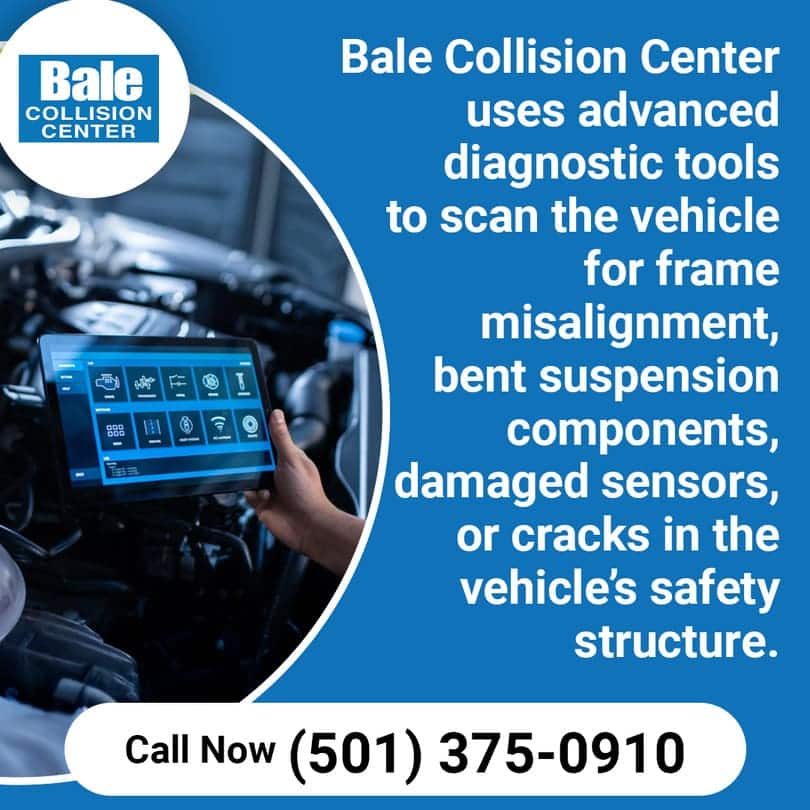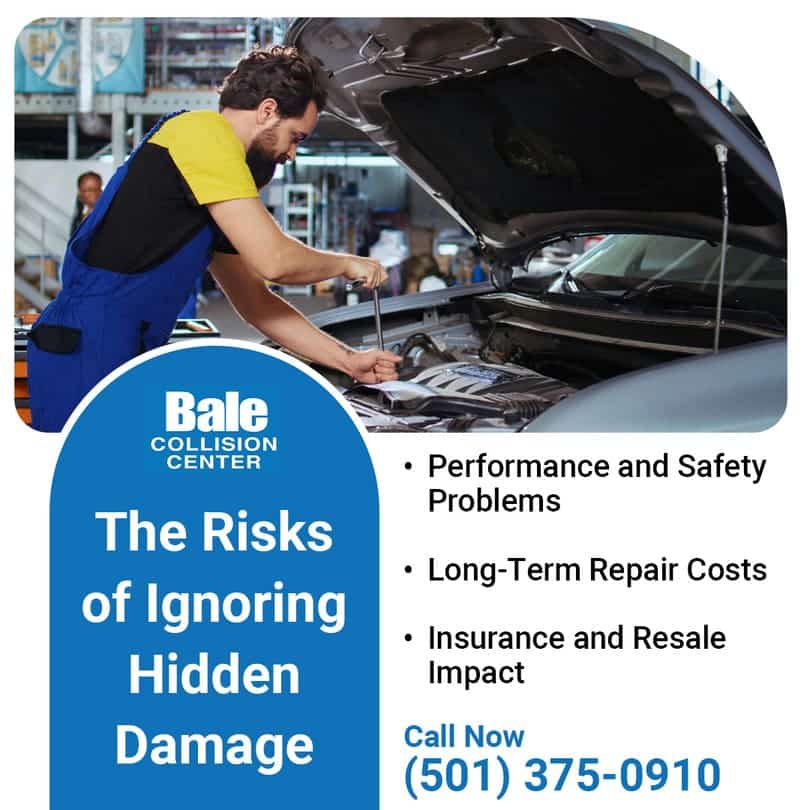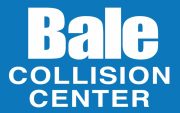Even if your car looks fine after an accident, damage beneath the surface can affect its structure, alignment, and safety features. These problems often start small with a bent frame rail or cracked sensor mount, but when ignored, they can develop into brake issues, steering instability, or airbag failure.
This article explains how hidden damage works, what can go wrong when it’s not handled properly, and why drivers in Little Rock must rely on trusted collision repair experts to get it done right the first time. At Bale Collision Center (Downtown), we have a team of trained technicians who specialize in structural and safety-related repairs and offer manufacturer-approved repair methods using advanced diagnostic tools. We restore your vehicle’s performance and protect your safety after any collision.

What Hidden Damage Really Means
Hidden damage refers to vehicle problems beneath the surface that aren’t visible after a crash. This can include frame misalignment, sensor damage, suspension issues, or internal cracks in structural components. Even small collisions can affect these parts, especially if the impact is not absorbed evenly.
For example, a front bumper might look intact, but the frame behind it could be pushed in by several millimeters. That misalignment could affect the steering or cause uneven tire wear. Similarly, crushed wiring or cracked mounts for electronic safety systems can go unnoticed unless a full diagnostic scan is performed.
At Bale Collision Center in Little Rock, we use factory-grade scanning tools and repair methods to detect hidden damage. Identifying this early prevents larger repairs later and maintains the value and safety of your car.
Common Issues That Aren’t Obvious Right Away
Subtle problems after a collision often include frame damage, bent suspension, or disconnected sensors. Some of the most common hidden issues found during inspections at our collision center in Little Rock, AR, include:
Misaligned unibody or frame: May cause the vehicle to drift or pull when driving.
Suspension damage: A bent control arm or strut mount can result in tire wear or poor handling.
Electrical sensor failures: Airbag sensors or lane-assist systems can be misaligned or broken without triggering a dashboard warning.
Why Surface Repairs Don’t Always Solve the Problem
Fixing only the visible damage doesn’t address the full extent of the impact. Many auto body collision shops focus on cosmetic work like repainting or replacing panels. But if no diagnostic testing or structural check is done, internal damage can remain.
For example, a new fender might hide a damaged crumple zone. That damage can reduce the car’s ability to protect passengers in a future crash. A misaligned camera in the bumper can also cause adaptive cruise control or parking sensors to malfunction, even if the bumper looks new.
At Bale Collision Center, we go beyond appearance. We follow OEM procedures to check every layer of the repair. This approach avoids the risk of future failure and makes sure your vehicle is returned to pre-accident condition.
Problems That Can Follow
Hidden damage that remains unrepaired can lead to serious safety concerns, performance issues, and repair costs over time. Even minor structural or internal issues may grow worse if left unchecked. This can affect how your vehicle drives, handles, and protects you during future collisions.
At Bale Collision Center in Little Rock, we see many vehicles needing secondary repairs months after an incomplete auto collision repair. Fixing collision damage early reduces repair costs and avoids safety risks later on.
Safety Features May Not Work As Intended
Advanced safety systems may fail if sensors or internal mounts are damaged. These systems rely on precise calibration. Even a tiny misalignment of a few millimeters or a degree or two in a radar/camera mount can significantly impair lane‑assist, collision‑warning, and airbag deployment systems. For example:
- A cracked radar bracket hidden behind the bumper may throw off collision avoidance alerts.
- If a blind-spot sensor isn’t properly reset, it could miss nearby traffic or give false alarms.
- A deactivated seatbelt pre-tensioner could fail in a crash, reducing protection for passengers.
According to the Insurance Institute for Highway Safety (IIHS), nearly half of drivers whose crash-avoidance systems were repaired after a collision reported ongoing issues with the technology. That’s why auto body collision shops must follow factory repair guidelines and use scan tools to restore these systems properly.
Frame Damage Can Get Worse Over Time
Even small frame misalignment can lead to greater problems if not fixed right away. When the frame is out of spec, it places uneven stress on the suspension and body. This can create issues like noise, vibration, or more costly wear.
Common signs of worsening frame damage include uneven gaps between doors or body panels, a pulling sensation while driving straight, or increased vibration at highway speeds.
More importantly, a weak frame can reduce crash energy absorption. That puts more force on the passengers in an accident. At Bale Collision Center, our collision repair specialists in Little Rock, AR, use computerized measuring systems to verify frame integrity to factory specs before and after repairs.
Steering and Suspension May Become Unstable
Handling will suffer if your car’s alignment, control arms, or suspension parts are damaged. Even a minor hit can bend a strut, knuckle, or tie rod. This can cause steering to feel loose or unstable, especially at higher speeds. Symptoms of suspension problems after a collision include:
- Uneven tire wear after a few hundred miles.
- Vehicle pulls or drifts despite alignment.
- Rattling or clunking sounds from under the car.
These issues often aren’t visible unless the car is lifted and inspected. At our auto body collision shop in Little Rock, we check alignment angles and suspension geometry as part of the full collision repair process. This protects long-term performance and tire life.
Costs That Build Up Later
Overlooking hidden damage often leads to more expensive auto collision repairs later. A slightly bent suspension arm or misaligned wheel may seem minor after a collision, but these can lead to uneven tire wear, poor alignment, and further damage to steering or braking systems. These delayed problems require more labor and parts than if they had been addressed earlier. This is why thorough inspection and complete repairs from a qualified collision center in Little Rock, AR, like Bale Collision Center, are so important for preventing long-term costs.
More Repairs Down the Road
Unrepaired collision damage increases the chance of additional mechanical failures later. If internal components like mounts, brackets, or structural supports are left damaged, they can fail slowly under stress.
For instance, suspension components that seem functional after a crash might already be weakened. After a few months, these parts can start to wear unevenly, causing noise, handling problems, or even safety risks. Likewise, overlooked drivetrain damage might not appear until the vehicle starts to vibrate or lose performance under normal use. Drivers often return for unexpected repairs that could have been avoided with a full structural and mechanical inspection during the collision repair process.
Lower Resale or Trade-In Value
Vehicles with incomplete repairs typically lose resale value, even if the exterior looks clean. Buyers and dealerships often use third-party vehicle history reports that show if a car was involved in an accident. If the car was not fully repaired or if there are signs of structural misalignment, electronic faults, or interior damage, it may be valued at thousands of dollars less.
Visible signs like uneven door gaps, unpainted components, or rust in wheel wells are red flags. More importantly, if diagnostic scans reveal unresolved issues with safety systems or sensors, buyers may reject the car altogether. According to industry data, a car with unresolved collision damage can lose up to 10–30% of its value. At Bale Collision Center, all collision repairs in Little Rock, AR, are documented and completed to manufacturer standards to protect the long-term value of cars.
Insurance May Not Cover Future Claims
Unrepaired or improperly repaired damage can lead to denied insurance claims later on. If a vehicle sustains further damage in the future, the insurance company may inspect the history and repairs. If they find that earlier damage wasn’t addressed properly, they may argue that some of the current damage stems from that prior incident and reduce or deny the claim.
For example, if a cracked subframe wasn’t fixed the first time, and it contributes to additional damage in a new collision, the insurer may only approve partial coverage. Likewise, a malfunctioning airbag system that was never recalibrated may become a liability issue.
Insurance carriers require proof that all collision repair work was performed by qualified technicians using approved procedures. That’s why our collision center in Little Rock, AR, keeps detailed repair records and uses certified methods for all structural, mechanical, and cosmetic work.
How Reputable Collision Centers Handle It
A trusted auto collision repair shop goes beyond surface fixes and inspects the entire vehicle. Many problems from an accident aren’t obvious at first glance. That’s why a quality collision center will take a methodical approach, checking both visible and hidden areas. This ensures that internal systems, structural components, and electronics are all inspected before repairs begin.
At Bale Collision Center, we follow documented procedures to confirm the safety and reliability of every repair. This includes using digital tools, checking manufacturer guidelines, and making sure all damaged parts are identified early.
Full Inspections with Modern Tools
Thorough auto collision repair begins with technology that detects damage the eye can’t see. Professional auto body collision shops rely on electronic measuring systems, diagnostic scanners, and digital frame equipment to catch damage that would be missed in a basic visual check. These tools help technicians confirm the condition of frame rails, suspension mounts, and safety systems like airbags or lane sensors.
For example, 3D measuring systems can show if the frame is even slightly out of alignment. Diagnostic scans can identify fault codes in steering, braking, or collision-avoidance systems. These steps help prevent future failures and make sure the vehicle performs as it did before the crash.
Manufacturer-Approved Repair Steps
Using repair methods approved by the manufacturer protects vehicle safety and warranty. Every make and model comes with specific repair guidelines.
Reputable collision repair facilities follow those instructions to make sure the correct materials, parts, and processes are used. For example, high-strength steel frames often require specialized welding techniques and replacement procedures. Using unapproved shortcuts or aftermarket parts may compromise safety or invalidate manufacturer coverage.
At Bale Collision Center, we follow OEM steps for collision repairs in Little Rock, AR, for all major brands. We make sure all parts fit as designed and all safety systems function correctly. This approach helps the vehicle meet its original crash standards and supports any remaining factory warranty.
Clear Communication About What’s Found
Reliable auto body collision shopsexplain all damage and repairs before any work begins. After inspection, a quality collision repair facility will walk the customer through the findings. This includes which parts are damaged, how they’ll be fixed, and what the cost estimate includes. Technicians should be able to explain why a sensor needs recalibration or why structural repairs must come before cosmetic ones.
At Bale Collision Center, transparency is part of every repair. Customers are shown scan results, measurement reports, and photos of any hidden damage. Clear communication helps drivers understand what’s being done and why it matters for safety, performance, and long-term value.

Why Bale Collision Center is a Top Choice for Collision Repairs in Little Rock, AR
Drivers in Little Rock trust Bale Collision Center because we focus on long-term repair quality. With precision tools and I-CAR Platinum-certified technicians, our process follows strict repair standards to restore your vehicle’s safety and structural integrity. Our team understands that hidden collision damage can lead to safety problems and future costs. That’s why each repair at our collision center in Little Rock, AR, is guided by training, diagnostics, and a commitment to getting the structural details right.
Trained Technicians with Experience in Structural Repairs
Bale Collision Center employs certified technicians who are trained in structural and frame repairs. Frame rails, crumple zones, and underbody panels often take the force of an impact. Our auto collision repair team understands how these parts affect safety and how they must be repaired according to the manufacturer’s specifications. Our technicians hold I-CAR Platinum certification, which involves regular hands-on training and testing.
This level of expertise helps in identifying hidden damage that can prevent future issues such as uneven tire wear, misaligned body panels, or weakened crash performance. By restoring the frame and structure correctly, we help customers avoid repeated issues and keep their vehicles on the road longer.
Equipment That Finds What Others Miss
We use advanced scanning and measurement tools that reveal damage traditional inspections can miss. Our facility is equipped with digital frame measurement machines, full-system diagnostic scanners, and calibration tools to catch these problems early.
This equipment helps us check things like steering angle sensors, ADAS camera alignments, and airbag module faults, which are issues that may not trigger a dashboard light but could fail in another crash.
Repair Plans Built Around Long-Term Results
Our auto collision repair plans are designed to restore safety, performance, and long-term reliability. Some auto body collision shops focus on fast turnaround or visible damage only. We take a different approach. At Bale Collision Center, each repair is based on what the vehicle needs to stay road-safe over time.
This includes verifying the structural integrity of the frame, ensuring all electronics and safety features work as intended, and confirming that paint and panel fitment meet factory standards. We also document each collision repair so customers have a clear record if they decide to sell or trade in their vehicle.
Talk to Our Team
Ignoring hidden collision damage can lead to higher costs, lower safety, and more repair issues later. Even if a vehicle looks fine on the outside, problems beneath the surface can affect its frame, electronics, and overall performance. That’s why it’s important to choose a collision repair center that understands how to find and fix the damage you can’t see right away.
At Bale Collision Center, we handle collision repairs in Little Rock, AR, with care, precision, and the right tools. Our team follows repair steps approved by the manufacturer and takes the time to explain what we find. If you’ve been in an accident, schedule a visit with our technicians. We’ll provide a full inspection and help protect your car’s value, safety, and long-term reliability.
Contact Bale Collision Center in Little Rock, AR, today to book an appointment or ask about our services. Call us at (501) 375-0910 or email bccdowntown@baleautomotive.com. Our trained technicians are here to help you get back on the road safely.
